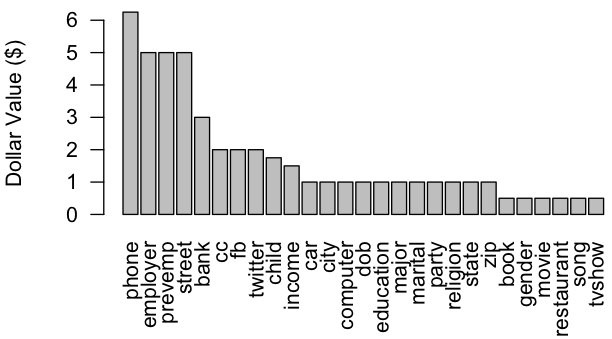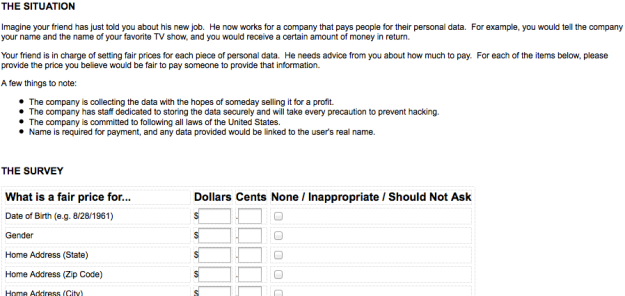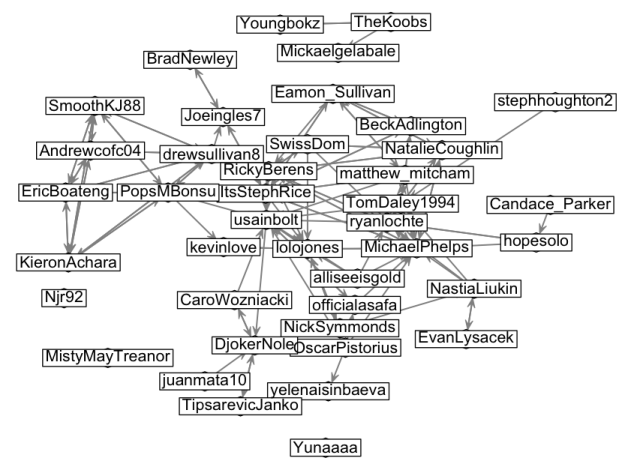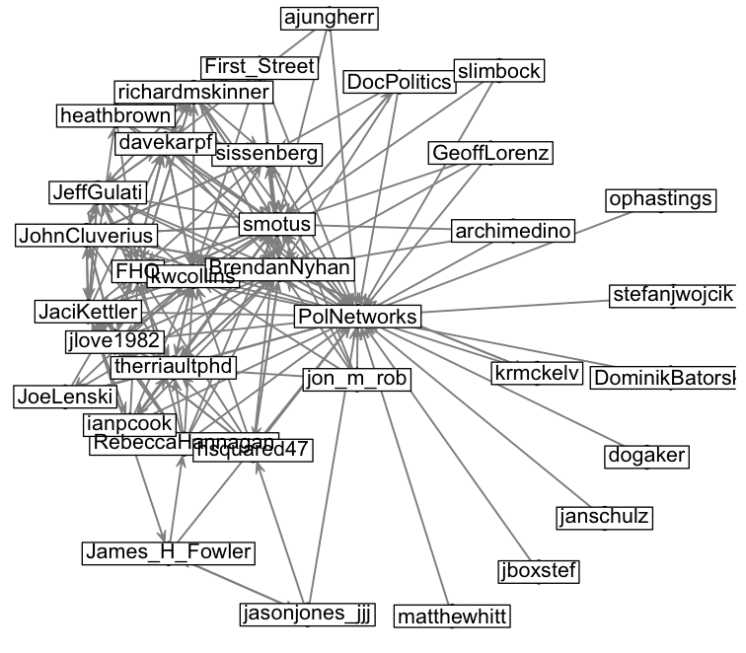The Olympics bring together the world’s most talented and dedicated athletes. And so does Twitter. As a part of my continuing effort to try to do interesting things with the Twitter API, I decided to create my own Olympics for Olympians on Twitter. Er, yeah I think that’s right.
To begin with I created the sociomatrix of Olympian Tweeters. A sociomatrix is a table where every person in a group gets a row and a column. Each cell in the table indicates whether a relationship exists between two people (the row person and the column person). To indicate this, one just places a zero in the cell if the relationship does not exist and one if it does.
|
Jack |
Rose |
Cal |
| Jack |
|
1 |
0 |
| Rose |
1 |
|
0 |
| Cal |
0 |
1 |
|
Example Sociomatrix. The relationship is row in love with column as per James Cameron’s Titanic.
I created a sociomatrix of Olympians on Twitter where the relationship was follows. Given a sociomatrix, row sums and columns sums are usually interesting, quick summaries of the data. In our case, a row sum is the number of Olympians one particular account follows. A column sum is the number of Olympians following a given account. So, without further ado, let’s get to our first event: Olympian most followed by other Olympians.
Most Followed (by other Olympians)
| Medal |
Olympian |
Followed By |
| Gold |
@BillyDemong |
30 |
| Gold |
@Shaun_White |
30 |
| Gold |
@ApoloOhno |
30 |
| Silver |
@lindseyvonn |
28 |
| Silver |
@emilycook |
28 |
| Bronze |
@GretchenBleiler |
25 |
Do they allow ties in the real Olympics? Probably not, but since these are virtual gold medals I’m handing out, why not?
You can probably guess the next event. And this would probably be the easiest event to win if you knew it was coming. We know who has the most followers, but who does the most following?
Most Follows (of Olympians)
| Medal |
Olympian |
Follows |
| Gold |
@emilycook |
73 |
| Silver |
@StevenHolcomb |
34 |
| Bronze |
@TFletchernordic |
32 |
The Sesquipedaliathon
| Medal |
Olympian |
Syllables per word |
Longest word |
| Gold |
@LMCHOLEWINSKI |
1.88 |
obesity |
| Silver |
@AngelaRuggiero |
1.58 |
sustainability |
| Bronze |
@Pchiddy |
1.57 |
anniversary |
In the sesquipedaliathon, Olympians compete on their vocabularies. Tweeters are ranked by the mean number of syllables in the words in their tweets. Polysyllabic expressions win out over short words.

Sesquipedalian tweets may be the mark of a skilled wordsmith discussing a complex topic, or they may be the result of needless pretentiousness. Syllables per word is one component of the Flesch-Kincaid readability scale. According to the Flesch-Kincaid scale, the more syllables-per-word one uses, the more sophisticated the writing (or the less readable the text, depending on how you want to look at it).
The gold winner @LMCHOLEWINSKI is tweeting at about a 10th grade level. @LMCHOLEWINSKI’s tweets clock in at about the same level as the discourse in the United States Congress, according to recent analyses.
(For fun, I checked the syllables per word my dissertation tweetbot outputs. At 1.61, my doctoral dissertation would take home a silver.)
Games-Dropping
| Medal |
Olympian |
Tweets about “Games” or “Olympics” |
| Gold |
@ShaniDavis |
19 |
| Silver |
@AngelaRuggiero |
17 |
| Bronze |
@GretchenBleiler |
16 |
For this event, Olympians score every time they use the word “games” or “Olympics.” So the medal winners are (presumably) those who are talking about the Olympics most often.
Sexy At-Mentions
| Medal |
Olympian |
Sexy At-Mentions |
| Gold |
@vitya_zvesda |
16 |
| Silver |
@lindseyvonn |
15 |
| Bronze |
@louievito |
11 |
Yes, it has come to this. I needed to find something to do with at-mentions, right? So why not count for each Olympian how many times someone calls them sexy in a tweet? And why stop with sexy?
One point for each tweet that mentions the athlete by their twitter handle and also contains one of the following words: hot, sexy, babe, handsome, pretty, beautiful or cute.
Non-Olympian Most Followed by Olympians
| Medal |
Tweeter |
Olympians Following |
| Gold |
@lancearmstrong |
30 |
| Silver |
@ConanOBrien |
24 |
| Bronze |
@BarackObama |
20 |
| Bronze |
@TheEllenShow |
20 |
| Bronze |
@StephenAtHome |
20 |
| Bronze |
@universalsports |
20 |
| Bronze |
@shitmydadsays |
20 |
This event was the toughest – as far as programming time goes. First, I grabbed everyone my list of Olympians follow. Then I aggregated to find out exactly how many Olympians followed each account. Then I filtered out Olympians to get this list of non-Olympians most followed by Olympians.
That’s the last of the events for now. Please check below for updates, and leave ideas for new Twitter Olympics events in the comments!
Resources
UPDATE: The list of Olympians used here came straight from Twitter’s verified accounts page. However, it’s rather wonky. I have a new, better list of London 2012 Olympians on Twitter and I’ll be re-running all of these analyses on this list. Check for a link to the London 2012 version of these events on Friday the 27th.
UPDATE: London 2012 Twitter Olympics now available.




